yea is real surprising King didn’t convoy from the get go. USA did the same thing in WWI, not learning from their allies. A bunch of guys got slaughtered because of it.
On this day during W.W. 2
-
These horses look very weird! Almost like tanks…
-
Nice picture.
-
October 25! Definitely the climax of the battle. October 25, 2024 is the 80th anniversary of the Battles of Samar, Surigao Strait, and Cape Engano, all the most important components of the battle.
Let’s start with Surigao Strait.
During nighttime on October 24-25 (i.e 22:36 October 24 to dawn on October 25), Vice Admiral Nishiruma’s Southern Force began entering Surigao Strait. Unfortunately, Vice Admiral Kinkaid’s Seventh Fleet had positioned a large number of forces in the area, forcing Nishiruma to run through a gauntlet of withering American attacks as he passed through the strait.
First, he had to pass through a concentrated torpedo nighttime attack by 28 destroyers and 39 torpedo boats stationed on either side of the strait, then face a line of 6 American battleships (5 of which damaged or sunk in the Attack on Pearl Harbor) and cruisers at the end of the strait crossing his T.
Despite emerging unscathed from the PT boat attacks, the Southern Force was annihlated by the American battleships, cruisers, and destroyers, with the battleship Fuso quickly being destroyed. While the American advantage in fire control helped immensely in targeting and sinking the Japanese ships, although due to its gunnery radar being less advanced, the battleship Pennsylvania was unable to locate anything and did not shoot. The battleship Mississippi fired the final battleship salvo against Yamashiro, being the last time a battleship would fire a salvo against another battleship in history.
After the battleship Yamashiro and 3 more destroyers were sunk (taking Nishiruma to a watery grave), the last two ships, the heavy cruiser Mogami and the destroyer Shigure turned and fled as fast as possible.
Around this time, Vice Admiral Shima’s Second Striking Force arrived at Surigao Strait. Upon seeing the destroyed remnants of Nishiruma’s fleet, he quickly ordered his ships to flee, with one of his heavy cruisers colliding with the Mogami, sinking the latter (Shigure would make it out alive, the legendary survivor).
Meanwhile, Kurita’s Center Force emerged out of San Bernardino Strait off the island of Samar, aiming to destroy the American transports landing at Leyte (this was actually also the goal of the Southern Force, but they obviously did not succeed). Because Kinkaid mistakenly thought Halsey left the Fast Carrier Task Force’s battleships to guard the straits when he didn’t, Kurita only encountered a set of escort carrier groups screened by a few destroyers and destroyer escorts, the first being Taffy 3 (Taffy 2 and Taffy 1 were further south). These escort carriers were mostly equipped for land attacks and anti-submarine warfare, almost entirely lacking the torpedos needed to sink the large battleships and cruisers the Japanese had.
Despite being outgunned, outmanned, outnumbered and outplanned, Taffy 3 made an all out stand, launching as many aircraft as possible and sending their escorting ships on suicidal charges, which validated Kurita’s initial belief that he was actually encountering Halsey’s carriers and battleships. Due to strict radio silence Kurita was never informed that the Japanese deception operation had succeeded. His order for a “General Attack” inflicted further chaos on the situation, with his ships becoming uncoordinated with each other.
This was the only time the Yamato (or any ships in its class, for that matter) would fire its massive guns at a surface target, helping sink the escort carrier Gambier Bay. 2 American destroyers and 1 destroyer escort were also sunk by Japanese ships, while the American sank the Japanese heavy cruisers Chokai, Suzuya, and Chikuma (unbelievably dismal for the Japanese given the situation, I might add).
In the end, Kurita, still believing that the Japanese plan failed, withdrew, sparing the American transport fleet. However, Taffy 3’s battle wasn’t over yet.
A set of Special Attack Forces launched the first two strikes in the history of the Pacific War, causing severe damage to two of Taffy 1’s escort carriers and sinking the escort carrier St. Lo from Taffy 3, as well as damaging the escort carriers White Plains, Kitkun Bay, and Kalinin Bay
During all of this (yes, a very busy day), the Fast Carrier Task Force launched 527 sorties against Ozawa’s Northern Force, sinking the fleet carrier Zuikaku (the last surviving member of the Pearl Harbor attack force) along with the light carriers Chitose and Zuiho, while the small force of Japanese planes that attacked beforehand (predictably) scored no hits. Task Force 34 was finally formed, but to close on the Northern Force after air strikes crippled it.
However, as the Battle Off Samar was raging, Halsey began recieving numerous, frantic calls for help from both Nimitz and and Kinkaid, but only after 3 hours did he order Task Force 34 to move southwards. A further delay of 2 and a half hours was spent refilling the task force’s destroyers, preventing them from intervening in the events off Samar in any meaningful way, even after Task Force 34.5, centered around the 2 fastest battleships in the fleet, Iowa and New Jersey, to charge at over 30 knots, was formed.
By the time Task Force 34.5 reached the exit of the San Bernadino Strait, they were only able to sink the Japanese destroyer Nowaki.
Concurrently with Task Force 34’s journey, a small force of cruisers and destroyers detached from it under Rear Admiral Dubose helped sink the light aircraft carrier Chiyoda, already crippled from air strikes earlier that day. Had they encountered Ozawa’s two battleships, Ise and Hyuga, the Americans may have been outgunned, but despite their efforts, the Japanese were unable to locate them.
Funnily enough, during Nimitz’s calls to Halsey for aid to the Seventh Fleet, he insterted as code padding (designed to confuse cryptographers) a loose quote from the famous poem “Charge of the Light Brigade”, as it was then the 90th anniversary of the battle the poem was based on, which means today also makes the 170th anniversary of the Battle of Balaklava.
Tune in tommorow when we wrap up this gargantuan battle!
-
@SuperbattleshipYamato what a fantastic post; thank you very much. Greatly appreciated.
-
Thank you so much!
-
October 26, 2024 is the 80th anniversary of the end of the Battle of Leyte Gulf. I’ll also be covering a few events that happened in the days afterward that were still connected to Leyte Gulf.
By this point, most of the fighting had ended, with the only event being the light cruiser Tama from the Northern Force, already crippled by Halsey’s airstrikes, being sunk by an American submarine (actually this took palce at 23:10 on October 25, but it’s close enough).
Overall, the Japanese experienced greater losses in the battle than the Americans, having lost 3 battleships, 1 fleet carrier, and 3 light carriers amongst others. The US Navy lost no ships bigger than the light carrier.
By the end of it, of the surviving battleships, only the Yamato, Haruna, Ise, and Hyuga were still battleworthy, with the Nagato and Kongo needing repairs.
The battle was a catastrophic loss for the IJN, as the failure to prevent the Americans from liberating the Phillipines meant that Japanese oil supplies would be cut off, preventing most of the surviving ships from being used in any significant way (this reasoning was actually why the Japanese head of the Combined Fleet, Soemu Toyoda, launched the attack in the first place despite the odds).
With the exception of Operation Ten-Go, which saw the Yamato and most of her supporting ships annihilated by American aircraft, the IJN’s surface ships would spend the rest of the war either as floating anti-aircraft batteries (the fate of most of the damaged larger ships), with the ones stationed in the home islands destroyed by American airstrikes on Japanese ports, or convoy missions, where many were sunk by American aircraft and submarines around the Phillipines later in the campaign (this fate awaited most of the Japanese destroyers). Whatever carriers Japan had left would be relegated to aircraft transports.
By the end of the war, with the Kongo sunk by an American submarine and the Ise, Hyuga, and Haruna destroyed in a large American attack at Kure’s naval base, the Nagato would become the only Japanese battleship still afloat (itself expended in US nuclear tests later in the 1940s).
The sole survivor of the Southern Force, the destroyer Shigure, already known for its incredible luck (alongside Yukikaze) surviving brutal battles, ultimately met its match when sunk by an American submarine early in 1945.
Halsey’s mistakes that nearly led to disaster would lead to heavy criticism, although his status meant that he would continue co-leading the war effort against Japan (alongside Spurance) in charge of the Fast Carrier Task Force.
Kurita’s retreat during the Battle of Samar led to criticism by the Japanese high command for not fighting to the death not too different from Gunichi Mikawa’s retreat during the Battle of Savo Island in 1942, where after inflicting lopsided losses during night surface combat, withdrew before he could destroy the transports landing at Guadacanal. Kurita was reassigned to an unimportant position, but would defend his withdrawal for the rest of his life, claiming he did it to save the lives of his men, having long believed the war was lost. He died in 1977.
Decades later, in 1975, Austrian historian Helmut Pemsel would determine by a semi-objective grading system that the Battle of Leyte Gulf was the largest naval battle of all time.
After 80 years, the Battle of Leyte Gulf still inspires countless what ifs and speculation and the stories of Kurita and Halsey continue to inspire people (mostly just me).
-
-
S Navy Sailors, survivors of the Battle off Samar the previous day, are rescued by a USN ship - October 26, 1944
Some 1,200 survivors of Gambier Bay CV 73, USS Hoel DD 533, USS Johnston DD 577, and USS Samuel B. Roberts DE 413 were rescued during the days following the action.
US Army Signal Corps - SC-278010
Pvt William Roof Photographer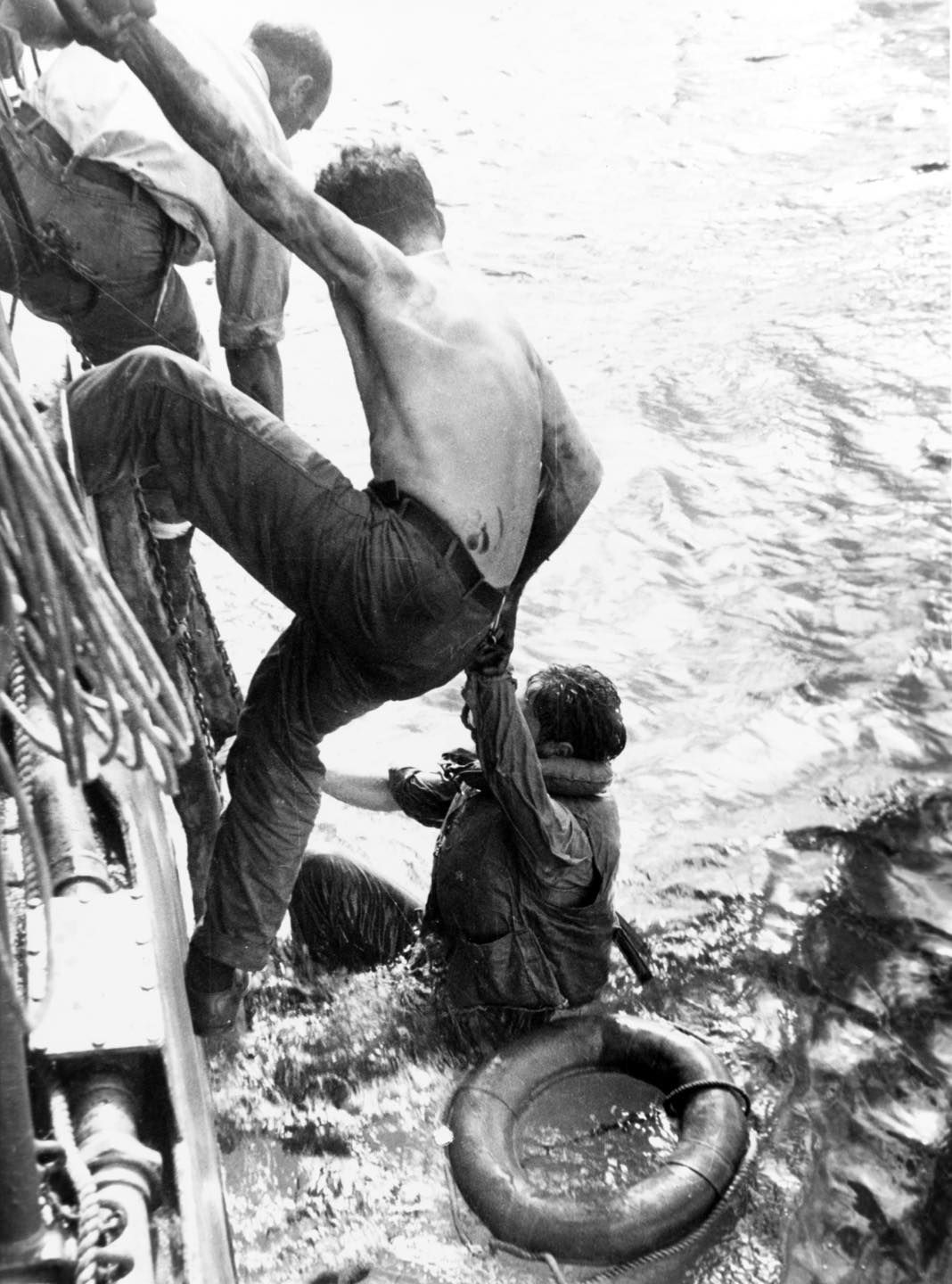
-
Nice.
-
British Crusader tanks at sunset during the Battle of El Alamein in North Africa - October 27, 1942
IWM - Silverside, John (Sgt) Photographer
IWM E 18642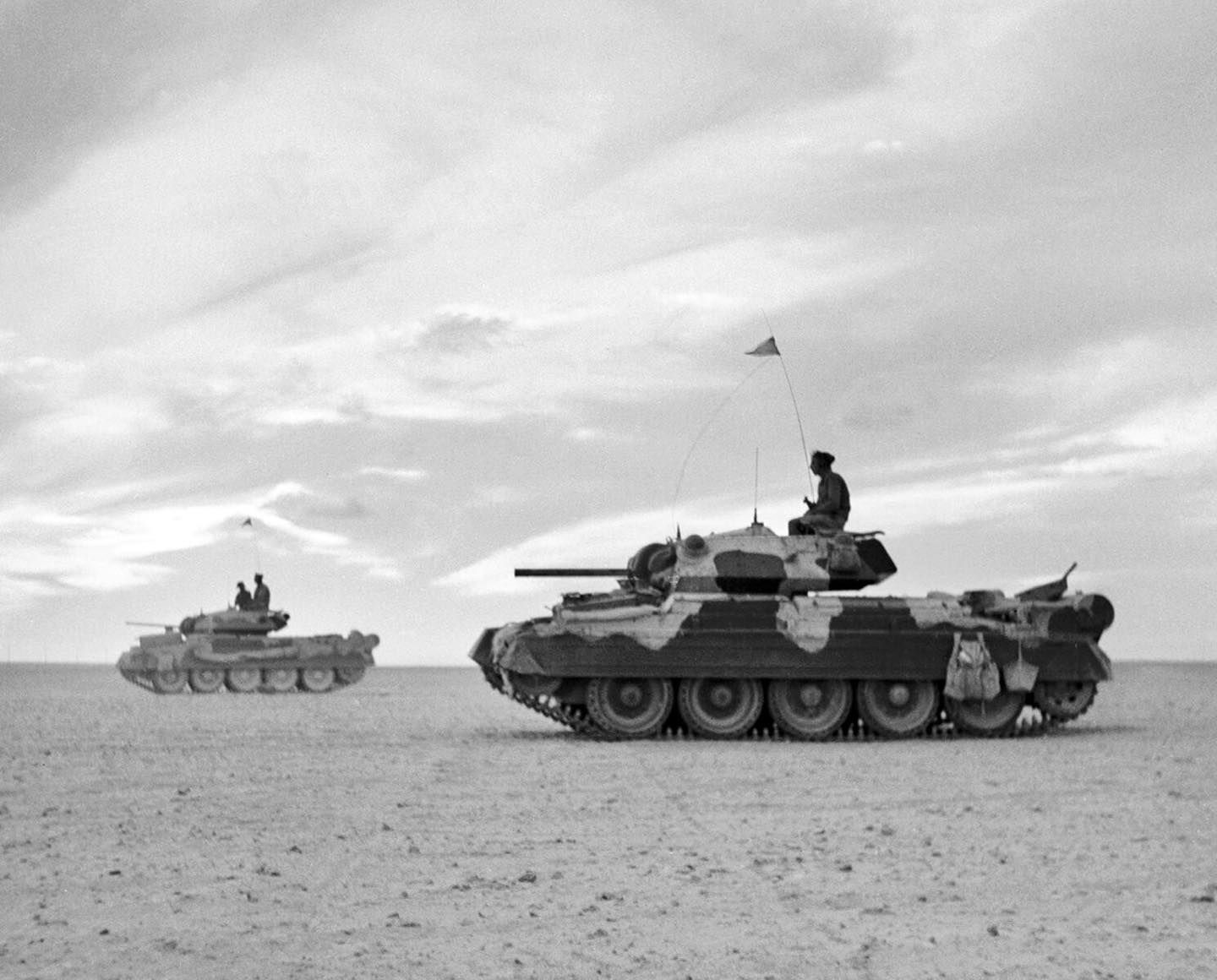
-
Oct 27 1942 the USS Hornet sinks during the battle of Santa Cruz. Picture is a Val dive bomber crashing into Hornet during the battle.
By U.S. Navy - U.S. Navy photo [1]/[2] from Hyperwar, Public Domain, https://commons.wikimedia.org/w/index.php?curid=879041
-
Incredible picture of an International Harvester Tractor photographed on the wreck of USS Hornet CV-8
This tractor would have been used as an aircraft tug
USS Hornet CV-8 was sunk during the Battle of Santa Cruz in the early morning hours of October 27, 1942 with the loss of 140 of her crew
Her wreckage was discovered on January 20, 2019 by RV Petrel
Picture Property of Paul G. Allen / Vulcan LLC
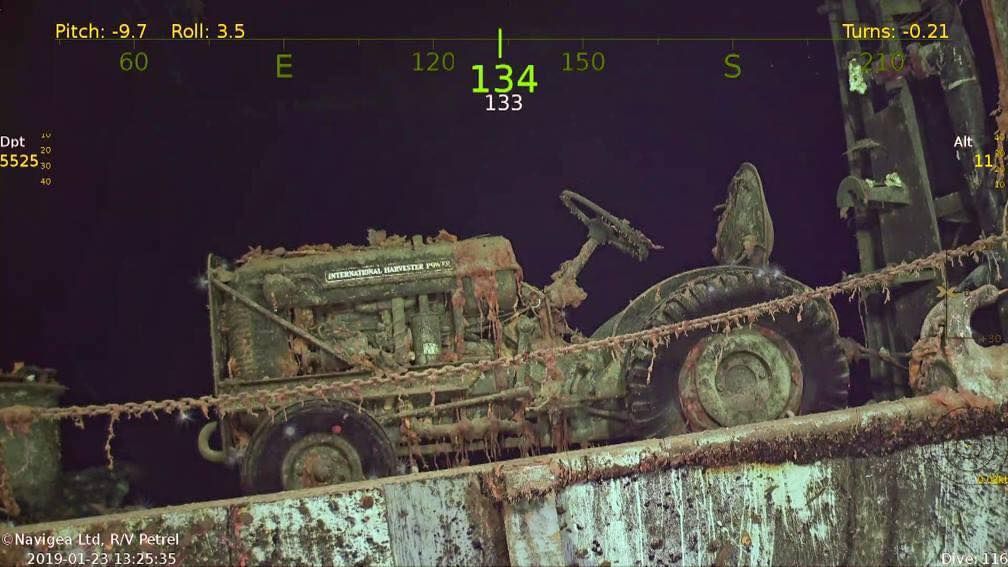
-
Impressive!
Ah… Santa Cruz… Japan’s last “major” victory…
(Major in quotation marks because the term in this case is subjective and it was still only a pyrrhic victory).
-
The Infantry of 51st Highland Division and Sherman M4 Composite tanks near Udenhout, Holland, 29 October 1944.
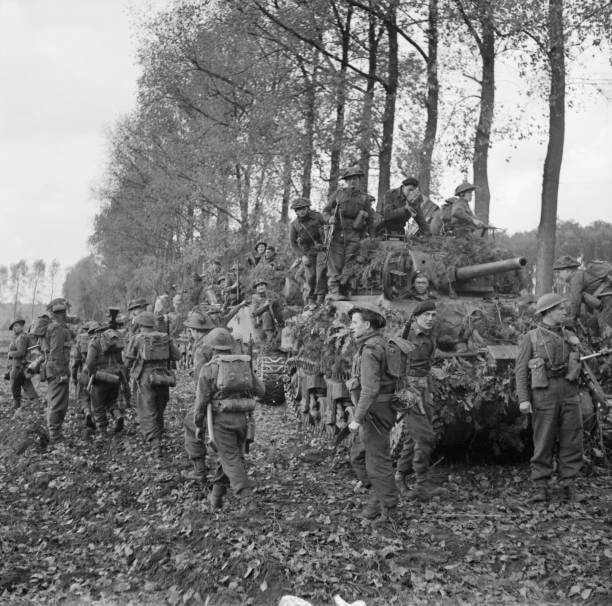
-
Nice.
-
Today, October 29th, is the 80th anniversary of the beginning of the Budapest Offensive, an attack by the Red Army’s 2nd and 3rd Ukrainian Fronts (imagine having so many army groups you can’t think of any unique names and have to number them) against German and Hungarian puppet forces to capture the city of Budapest (obviously).
The Offensive wouldn’t end until 1945, and the fighting in and around Budapest would be brutal, with the Germans mounting several attempted semi-major counteroffensives.
-
As the US continues to grapple with 2024’s elections, November 7, 2024, marks the 80th anniversary of the 1944’s elections.
Incumbent Franklin Delano Roosevelt and his new running mate, Harry Truman, won by a landslide against Thomas Dewey.
Due to Roosevelt’s declining health, his death early in 1945 caused Truman to take over and direct the rest of the American war effort, with long-standing effects for the postwar era and the early Cold War.
-
November 8, 2024 is the 80th anniversary of the end of the Battle of the Scheldt.
Following the failure of Operation Market Garden, the First Canadian Army led a month-long effort to clear the Scheldt river of German forces to open up the port of Antwerp for shipping. Following the victory, it would take several more weeks for the river to be demined and Antwerp deemed safe for ships. The time it took to clear Antwerp and the resulting supply shortages along the Western Front was a major factor in prolonging the war to 1945.
-
Flight Lt Józef Żulikowski of No. 306 Polish Fighter Squadron in the cockpit of his Spitfire IXC (BS456, UZ-Z) at RAF Northolt - November 16, 1942
Daily Sketch Photographer
IWM HU 87411 WWP-PD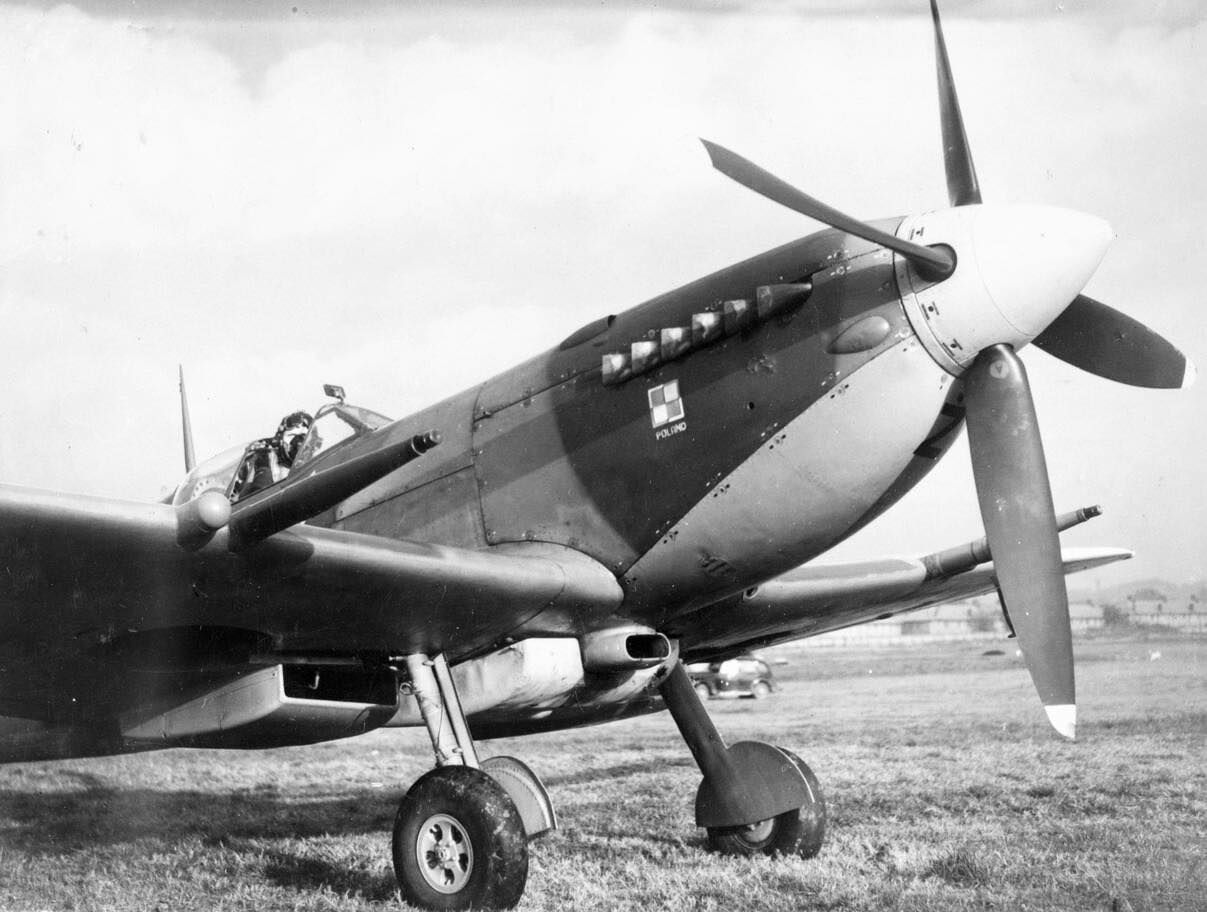
-
Nice.






